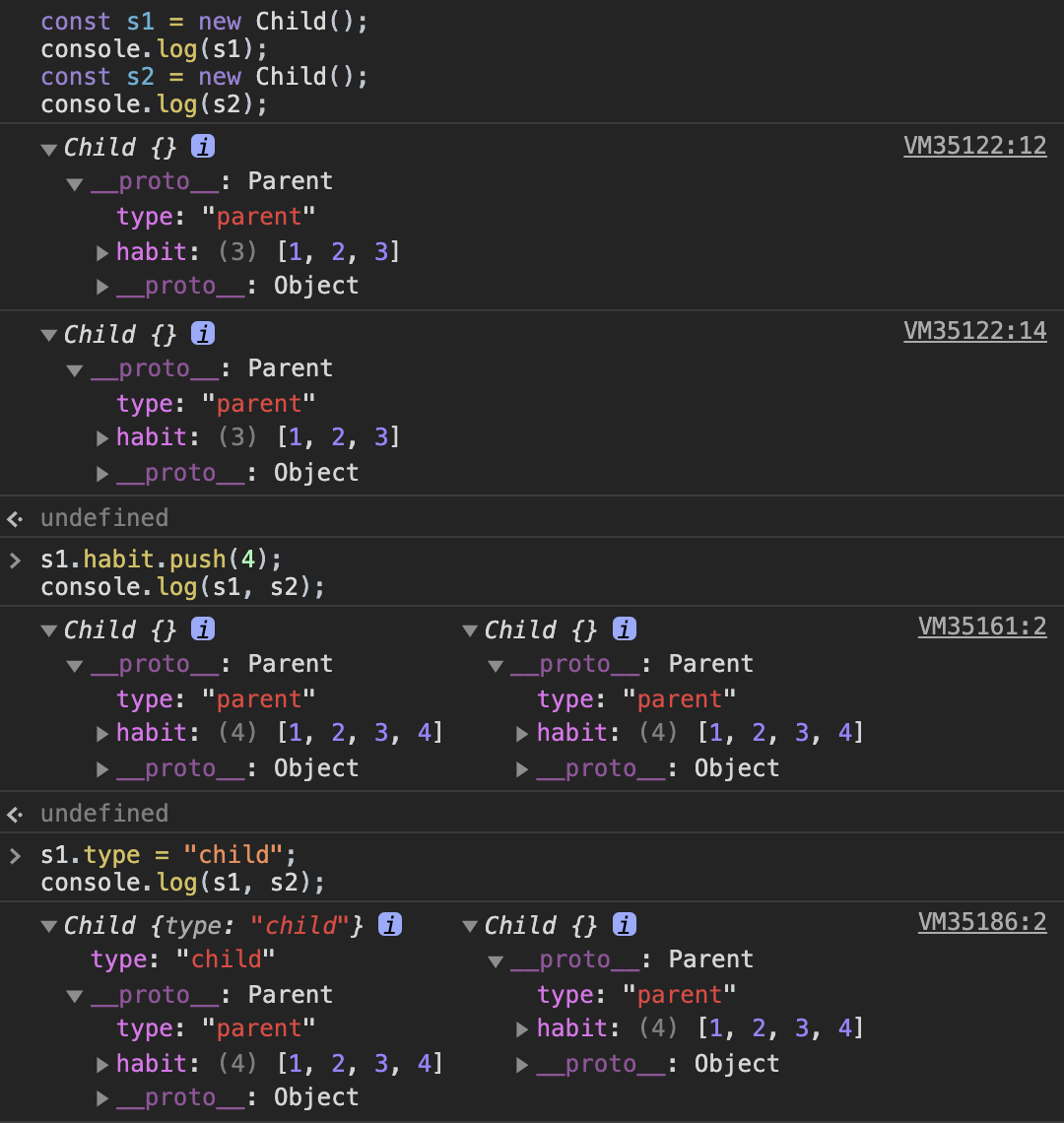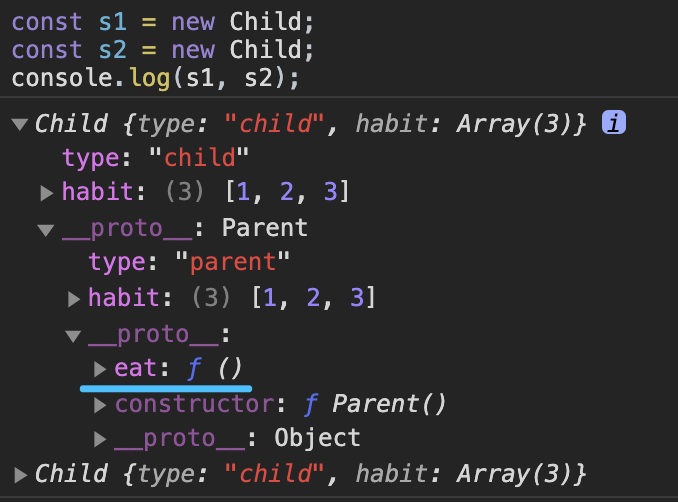# 类与继承
JS中继承的本质就是通过
原型链
# 继承的几种方式
# 1、原型链实现 继承
function Parent() {
this.type = "parent";
this.habit = [1, 2, 3];
}
function Child() {
}
// const s1 = new Child();
// console.log(s1.type); // undefined,这里注意在原型链改变之前实例化s1的话,s1的原型链就断了
Child.prototype = new Parent();
const s1 = new Child();
console.log(s1);
const s2 = new Child();
console.log(s2);
s1.habit.push(4);
console.log(s1, s2);
s1.type = "child";
console.log(s1, s2);
# 控制台输出结果

# 解释
原型链中的原型对象Parent,对于多个实例如s1与s2来说是共有公用的。由于构造函数Child是空对象,所以实例s1与s2开始是没有实例属性的。
- 当给s1.habit增加一个4,由于habit是引用类型,实例中没有该属性,则会通过原型链添加到原型对象Parent中的habit上,而它是共有的,所以s1.habit访问时也会到达原型对象的habit(
s2.__proto__ === s1.__proto__); - 当给s1.type赋值时,由于type是个原始类型属性,所以相当于是在实例s1中添加了实例属性type="child",而不会去改变原型对象,所以s1.type==="child",而s2.type==="parent";
结论
综上,原型链继承的缺点是:原型上任何类型的属性值都不会通过实例被重写,但是引用类型的属性值会受到实例的影响而修改,所以引用类型的属性值可能被误操作而导致所有实例都改变。
# 2、借用构造函数 继承
function Parent() {
this.type = "parent";
this.habit = [1, 2, 3]
}
function Child() {
Parent.call(this);
this.type = "child"; // 这里因为与Parent有同名属性type且后执行,会覆盖Parent.中的type
this.height = "small";
}
Parent.prototype.say = function() {
console.log("Hello~")
}
const s1 = new Child; // 不传参数时可以省略()
const s2 = new Child;
console.log(s1, s2);
# 控制台输出结果

# 原理
- 我们知道,函数只不过是一段可以在特定作用域执行代码的特殊对象,我们可以通过 call或apply 方法指定函数的作用域;
- 借用构造函数继承,就是
在子类的构造函数中,通过 apply() 或 call()的形式,调用父类构造函数,以实现继承; - 子类构造函数创建的实例s,会调用父类构造函数
生成属性副本,从而实现继承父类实例属性,且多实例间互不影响。但对于父类原型对象上的属性无法继承,比如上面的say()方法,因此只能算是部分继承;
结论
综上,借用构造函数继承的缺点是:只实现了部分继承,父类的原型对象上的属性无法被子类继承。
# 3、组合继承(原型链+借用构造函数)
组合继承:结合借用构造函数拷贝属性副本,与原型链继承共有属性(即将需要复用的方法提出到父类的原型对象上去挂载)相结合,从而更好实现继承。
function Parent() {
this.type = "parent";
this.habit = [1, 2, 3];
}
//将需共享的方法放到 Parent.prototype 中,实现复用
Parent.prototype.eat = function () { console.log('吃吃喝喝') }
function Child() {
Parent.call(this);
this.type = "child"
}
Child.prototype = new Parent();
const s1 = new Child;
const s2 = new Child;
console.log(s1, s2);
# 控制台输出结果

# 组合继承优化
需要优化的点有两个:
- 解决Parent执行两次的问题:
Parent.call(this)与new Parent()执行了两次,是没有必要的。继承的本质就是将父类的原型对象引用到子类的原型对象上,因此可以简化构造函数执行过程,直接将父类原型对象赋值给子类原型对象即可:
function Parent() {
this.type = "parent";
this.habit = [1, 2, 3];
}
//将需共享的方法放到 Parent.prototype 中,实现复用
Parent.prototype.eat = function () { console.log('吃吃喝喝') }
function Child() {
Parent.call(this);
this.type = "child"
}
Child.prototype = Parent.prototype; // 替换 new Parent();
const s = new Child;
s.constructor === Parent // true,这里还有遗留问题
- (完美继承)解决s.constructor指向问题:优化1中还有个问题没解决就是
实例对象s的构造函数依然是父类Parent。可以通过引入一个中间对象,来隔离子类原型对象与父类原型对象,并手动改变子类原型的构造器为自己本身:
function Parent() {
this.type = "parent";
this.habit = [1, 2, 3];
}
//将需共享的方法放到 Parent.prototype 中,实现复用
Parent.prototype.eat = function () { console.log('吃吃喝喝') }
function Child() {
Parent.call(this);
this.type = "child"
}
Child.prototype = Object.create(Parent.prototype); // 使用 Object.create(父类原型对象)创建一个以父类原型为原型对象的中间对象
Child.prototype.constructor = Child; // 手动改变实例s的原型对象构造器指向
const s = new Child;
s.constructor === Parent // false
s.constructor === Child // true
